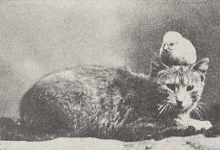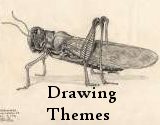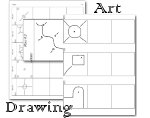My Opinion of Handbook of Nature Study
There is no other handbook for nature study that can compare to this one. First published in 1911 and later revised in 1939, this book has been used by countless teachers and others who wish to learn about the glorious natural world that we share. The Handbook of Nature Study has 887 pages and encompasses all living things, except humans, as well as non-living things such as rocks and minerals, the heavens, and the weather.
 When I open and read the Handbook of Nature Study is does not fail to impress me. It is clear to me that Anna Botsford Comstock loved what she did. A few weeks ago when I was researching aphids, I had several resources at my disposal; I had two encyclopedias: World Book and Britannica, I used Christian Liberty Nature Reader, Book 4, some gardening books and Handbook of Nature Study. They were all valuable resources, but the Nature Reader and the Handbook of Nature Study were written in an engaging style. The Handbook of Nature Study followed through with a "Method" and that included a list of observations that students could do with a magnifying glass and a leaf covered with aphids.
When I open and read the Handbook of Nature Study is does not fail to impress me. It is clear to me that Anna Botsford Comstock loved what she did. A few weeks ago when I was researching aphids, I had several resources at my disposal; I had two encyclopedias: World Book and Britannica, I used Christian Liberty Nature Reader, Book 4, some gardening books and Handbook of Nature Study. They were all valuable resources, but the Nature Reader and the Handbook of Nature Study were written in an engaging style. The Handbook of Nature Study followed through with a "Method" and that included a list of observations that students could do with a magnifying glass and a leaf covered with aphids.
My suggestion regarding Handbook of Nature Study is that if you have the book or purchase one, then be certain to use it. It is big (887 pages) but do not let that discourage you from taking it from the shelf and reading parts of it to your children. The first 24 pages, Part I: The Teaching of Nature-Study, are especially for you, the teacher. It contains many topics that should be helpful to you in the teaching of nature. The topics are listed below.
- What Nature Study Is
- What Nature Study Should do for the Child
- Nature-Study as a Help to Health
- What Nature Study Should do for theTeacher
- When and Why the Teacher Should say, "I don't know!"
- Nature-Study, the Elixir of Youth
- Nature-Study as a Help in School Discipline
- Relation of Nature-Study to Science
- Nature-Study Not for Drill
- The Child Not Interested in Nature-Study
- When to Give the Lesson
- The Length of the Lesson
- The Nature-Study Lesson Always New
- Nature-Study and Object Lessens
- Nature-Study in the Schoolroom
- Nature-Study and Museum Specimens
- The Lens, Microscope and Field-glass as Helps
- Use of Pictures, Charts and Blackboard Drawings
- The Use of Scientific Names
- The Story as a Supplement to the Nature-Study Lesson
- The Nature-Study Attitude toward Life and Death
- Should the Nature-Study Teacher Teach How to Destroy Life?
- The Field Note-book
- The Field Excursion
- Pets as Nature-Study Subjects
- The Correlation of Nature-Study with Language Work
- The Correlation of Nature-Study with Drawing
- The Correlation of Nature-Study with Geography
- The Correlation of Nature-Study with History
- The Correlation of Nature-Study with Arithmetic
- Gardening and Nature-Study
- Nature-Study and Agriculture
- Nature-Study Clubs
- How to Use this Book
The Handbook of Nature Study has Four Parts
- The Teaching Of Nature Study [index listed above]
- Animals
- Plants
- Earth And Sky
Each Part Is Divided Into Topics
- The Topics under Animals
- Birds
- Fishes
- Amphibians
- Reptiles
- Mammals
- Insects
- Insects Of The Fields And Woods
- Insects Of The Brook And Pond
- Invertebrate Animals Other Than Insects
Each Topic Contains Numerous Articles
The topic of birds is around 140 pages long and has over 50 articles. In each article, Anna Comstock has written in beautiful detail about the subject. There's usually a black and white photo included and a lesson at the end of the article about the subject. Some articles include a poem about the subject that was written by a published poet.
A Review Example of a Typical Lesson
from the book, Handbook of Nature Study, by Anne Botsford Comstock Lesson 64
Lesson 64
The Cat
LEADING THOUGHT - The cat was made a domestic animal before man wrote histories. It gets it prey by springing from ambush and it is fitted by form and body to do this. It naturally hunts at night and has eyes fitted to see at dark.
METHOD - This lesson may be used in primary grades by asking a few questions at a time and allowing the children to make their observations on their own kittens at home, or a kitten may be brought to school for this purpose. The upper grade work consists of reading and retelling or writing exciting stories of great, wild, savage cats, like the tiger, lion, leopard, lynx, and panther.
OBSERVATIONS -
- How much of Pussy's language do you understand? What does she say when she wishes you to open the door for her? How does she ask for something to eat? What does she say when she feels like conversing with you? how does she cry when hurt? When frightened? What noise does she make when fighting? When calling other cats? What are her feelings when she purrs? When she spits? How many things which you say does she understand?
- How else than by voice does she express affection, pleasure, anger? When she carries her tail straight up in the air is she in a pleasant mood? When her tail "bristles up" how does she feel? What is it a sign of when she lashes her tail back and forth ?
- What do you feed to cats? What do they catch for themselves? What do the cats that are wild live upon? How does the cat help us? How does she injure us?
- How does a cat catch her prey? Does she track mice by scent? Does she catch them by running after them like a dog does? Describe how she lies in ambush. How does she hold the mouse as she pounces upon it? How does she carry it home to her kittens?
- Study a cats paws to see how she holds her prey. Where are the sharp claws? Are they always in sight like a dog's? Does she touch them to the ground when she walks? Which walks more silently, a dog or a cat? Why? Describe the cat's foot including the toe pads. Are there as many toes on the hind feet as the on front feet? What kind of track does the cat make in the snow? How does she set her feet to make such a track? How does she sharpen her claws? How does she use her claws for climbing? How far have you ever seen a cat jump? Does she use her front or her hind feet in making the jump? On which feet does she alight? Does she make much noise when she alights?
***********************
This is not all of the questions, there are 8 more sections of cat questions.
Following the questions are some ideas for writing class and it is as follows:
***********************
14. Write or tell stories on the following subjects:
- The things which my pet cat does
- The wild cat
- The lion
- The tiger
- The leopard
- The panther and the mountain lion
- The lynx
- The history of domestic cats
- The different races of cats, describing the manx, the persian, and the angora cats
by Anne B. Comstock, 1911
*************************




 Walls are hard, just ask any crane fly.
Walls are hard, just ask any crane fly.



